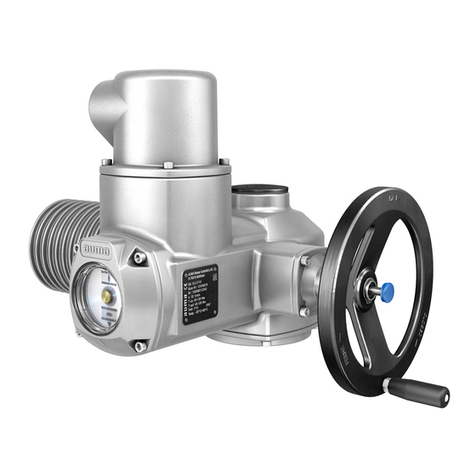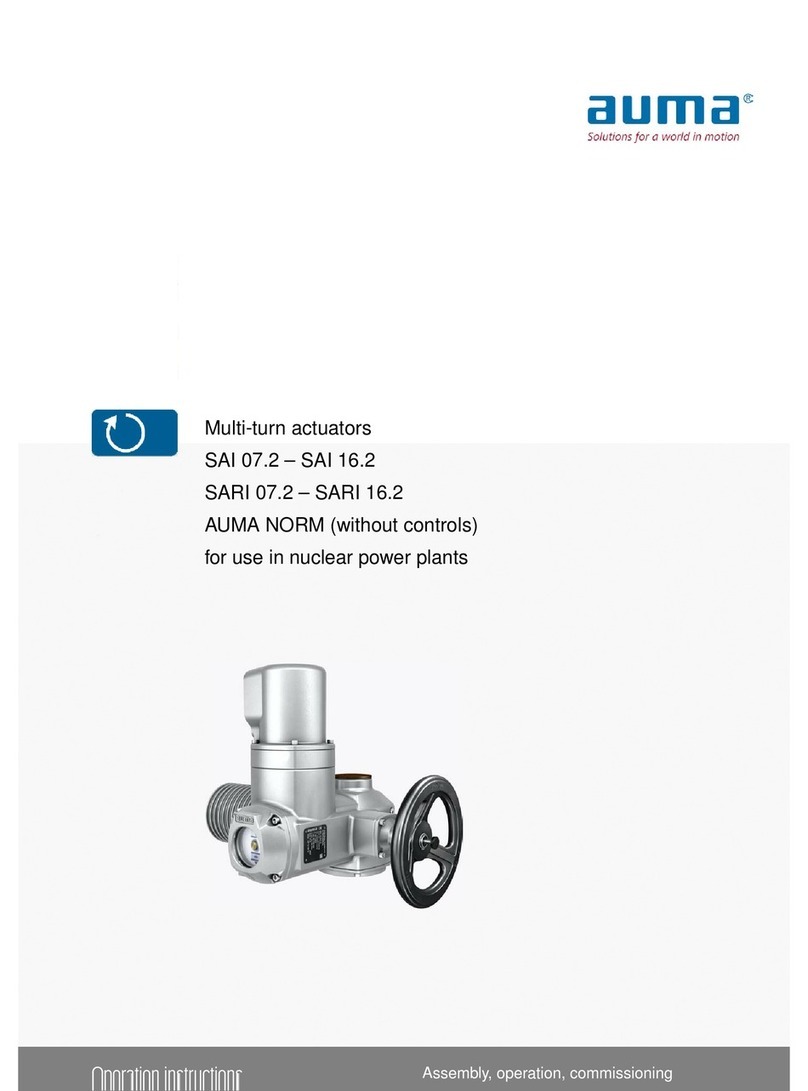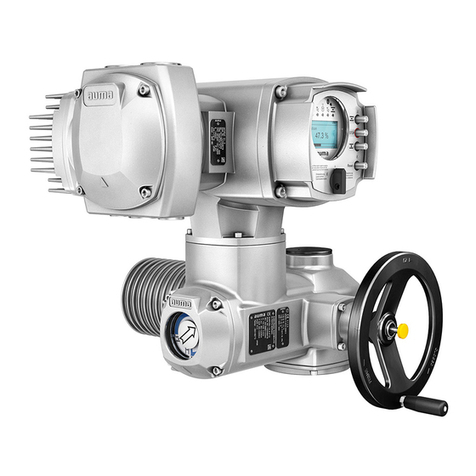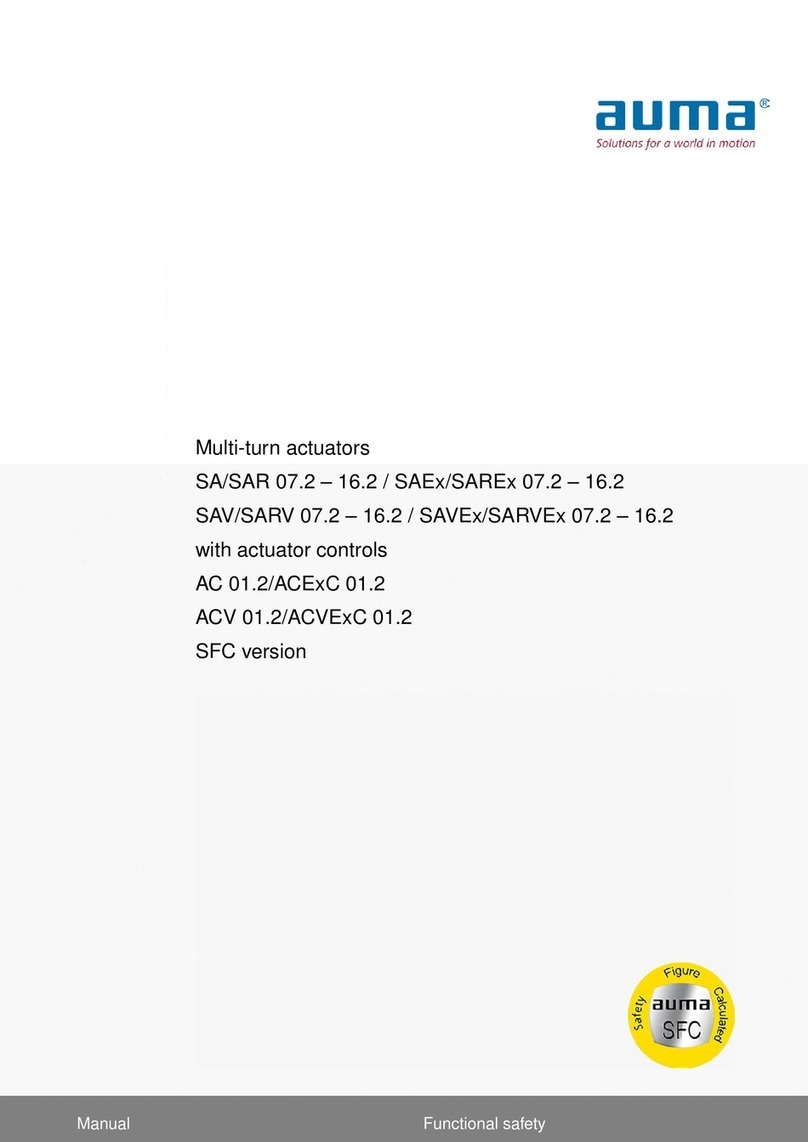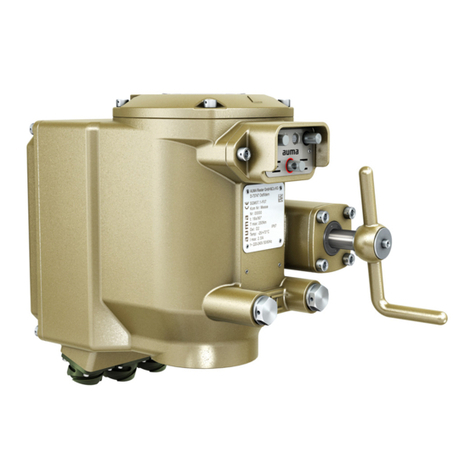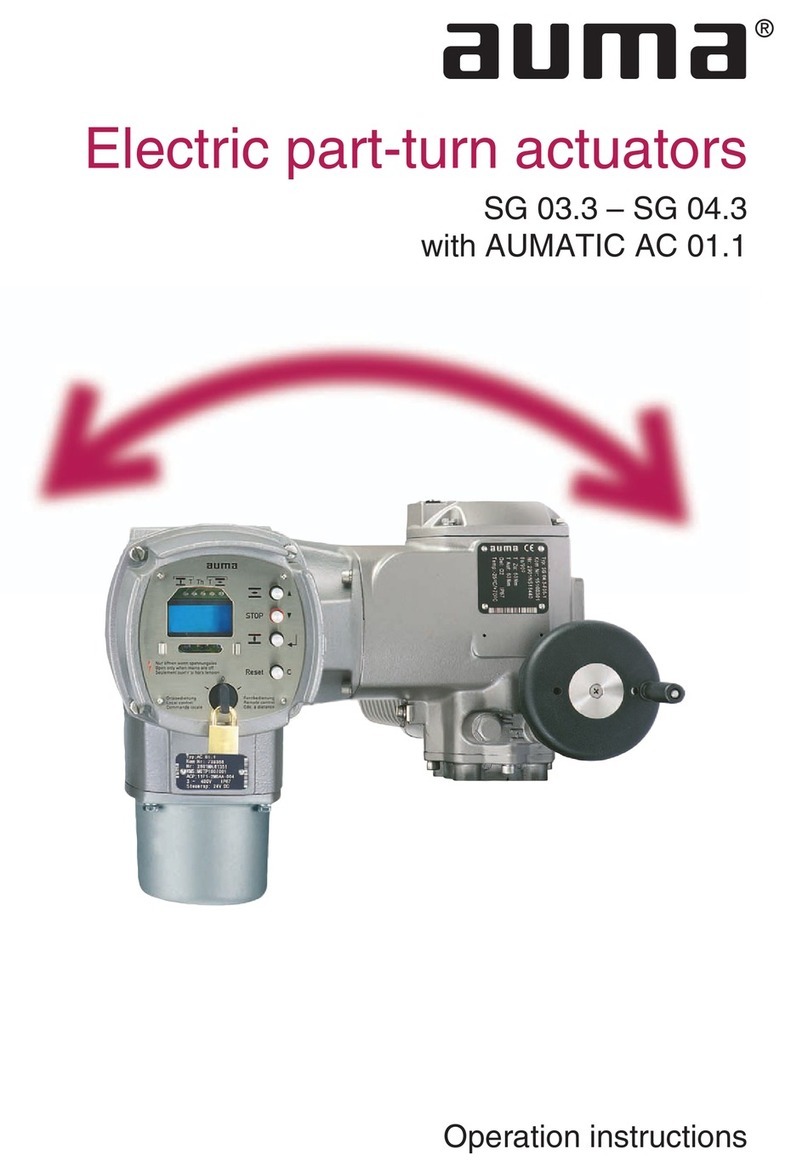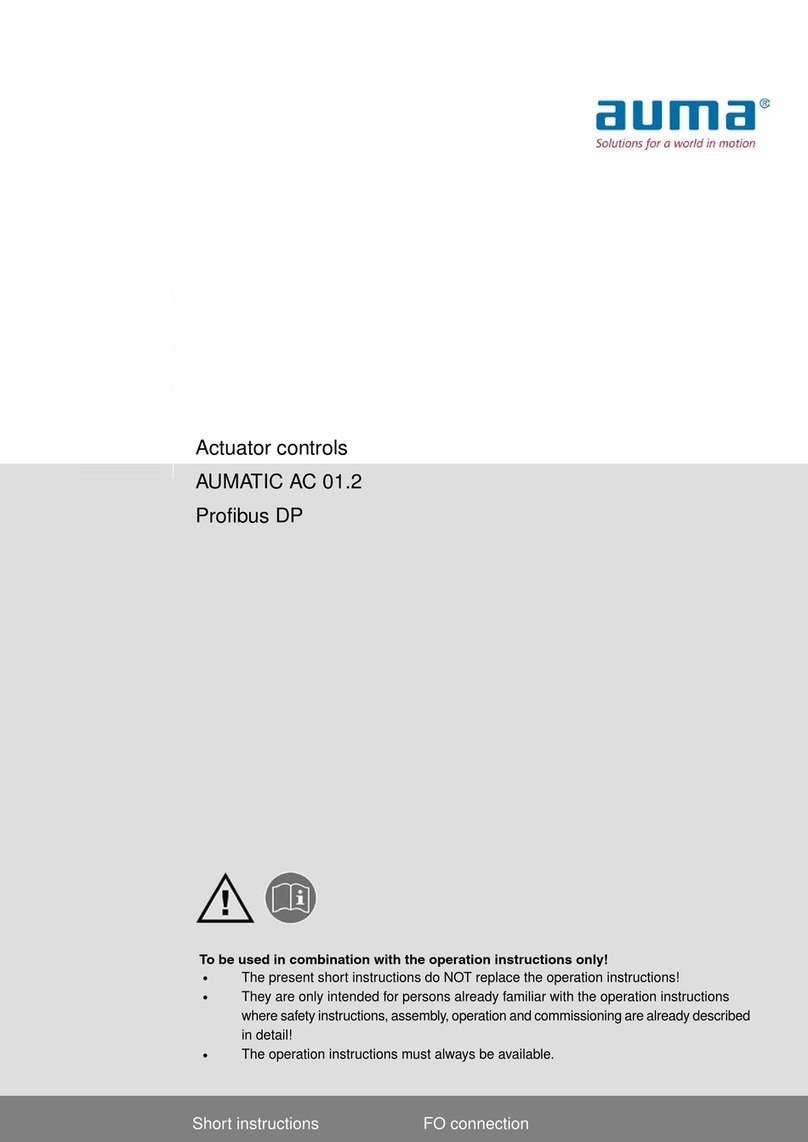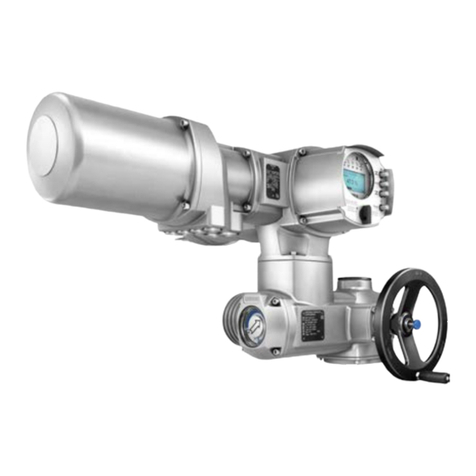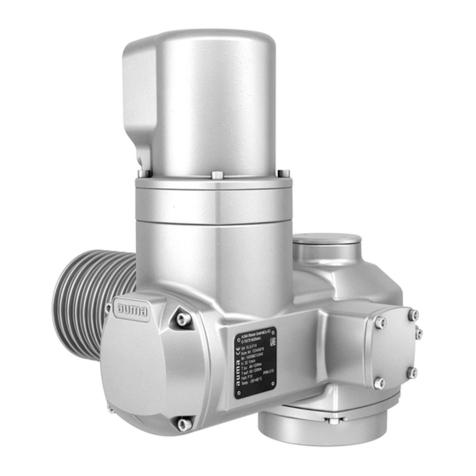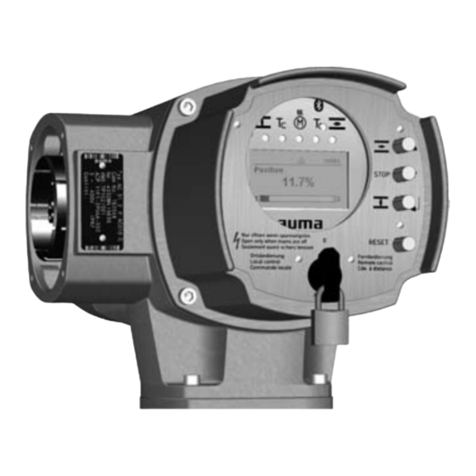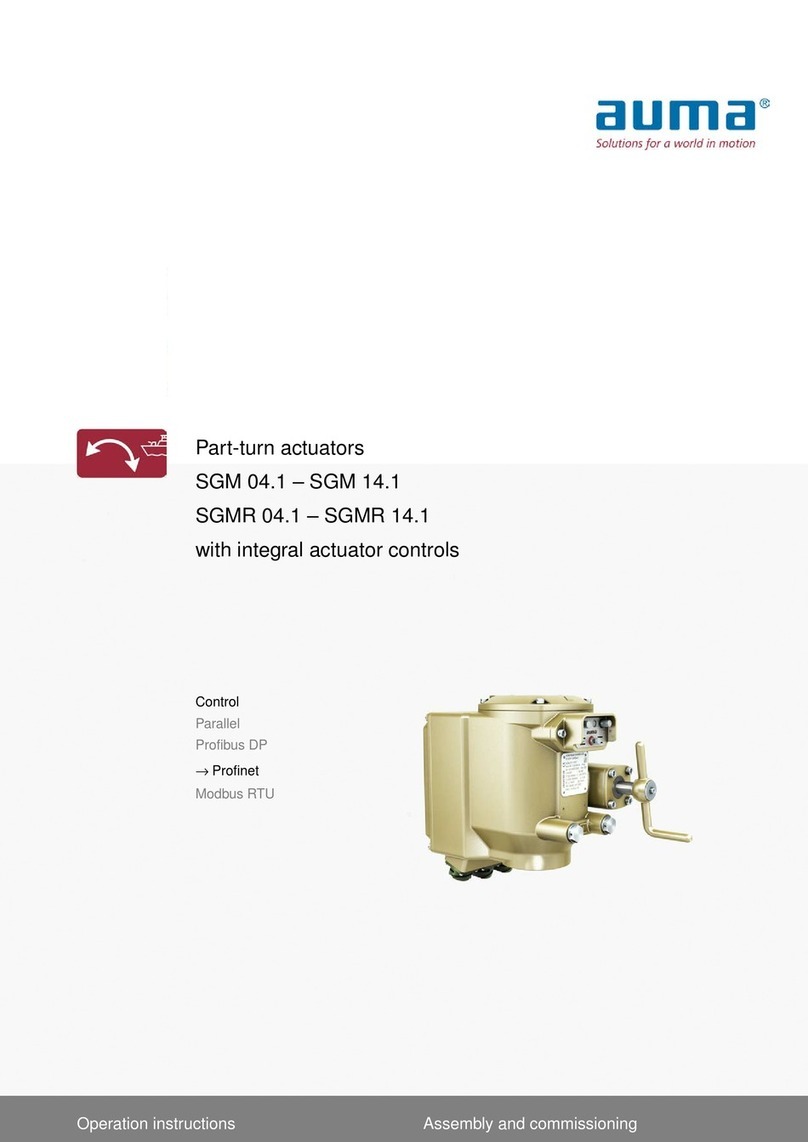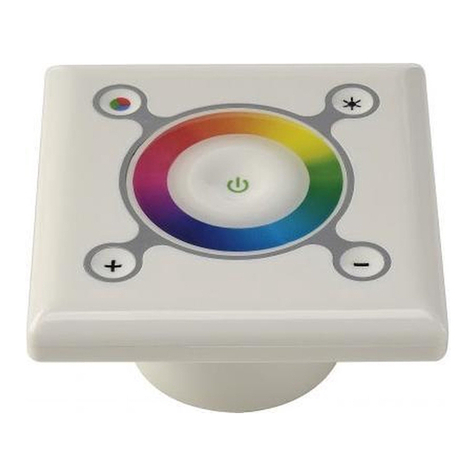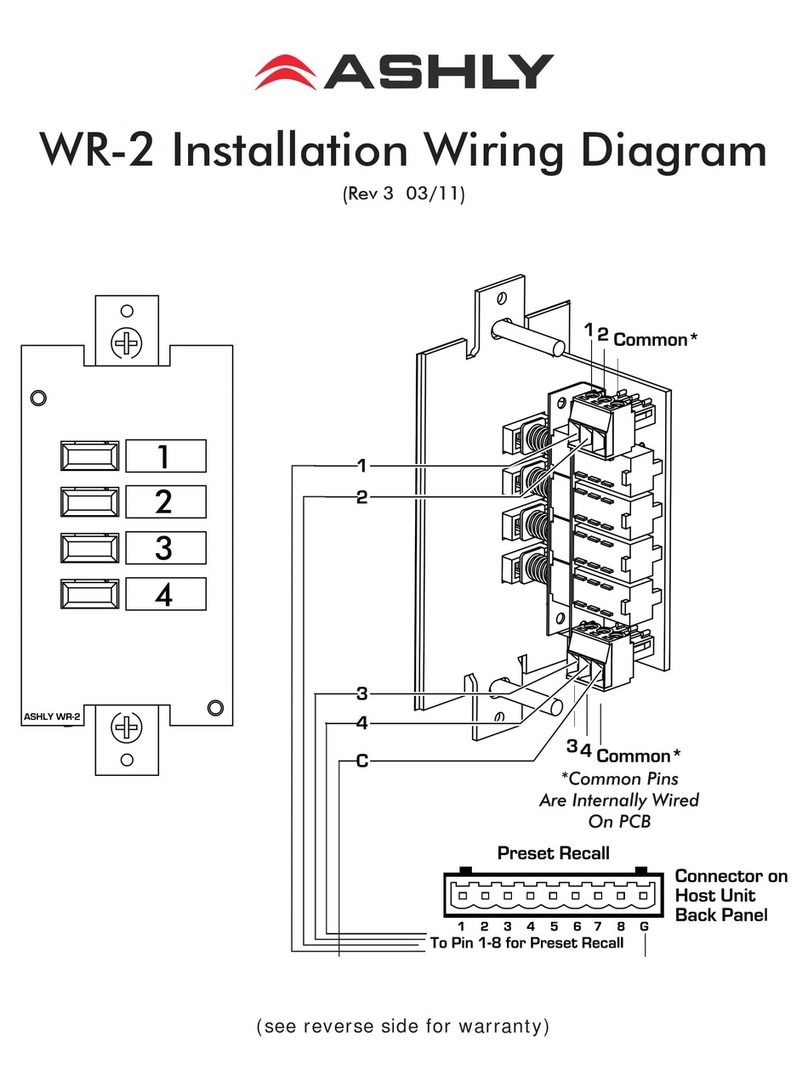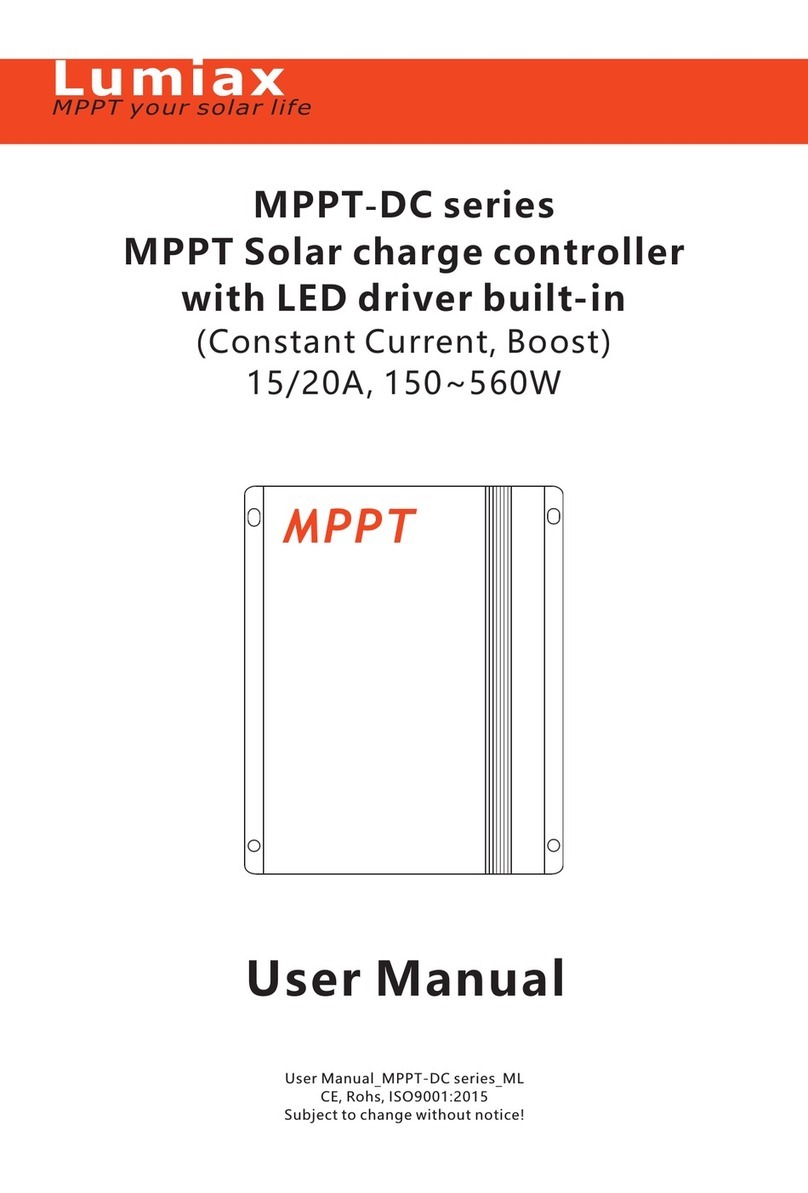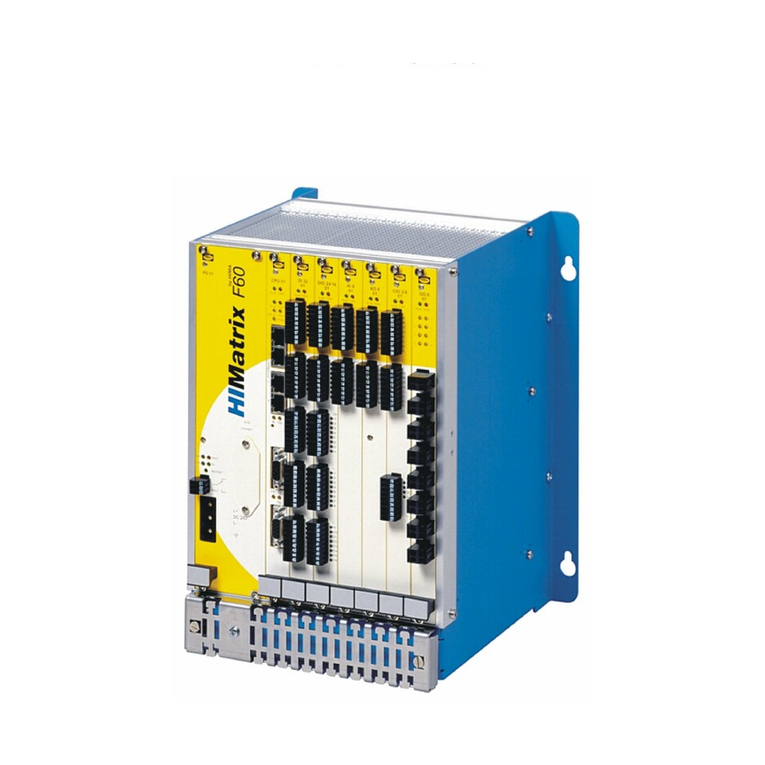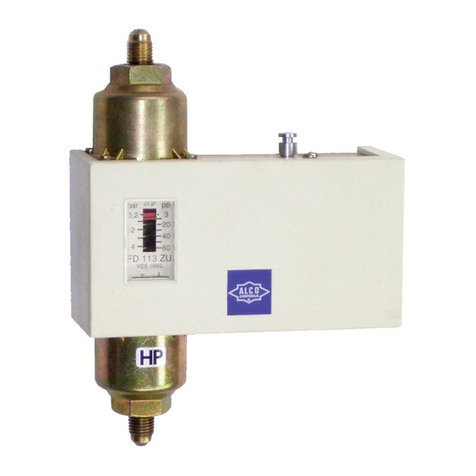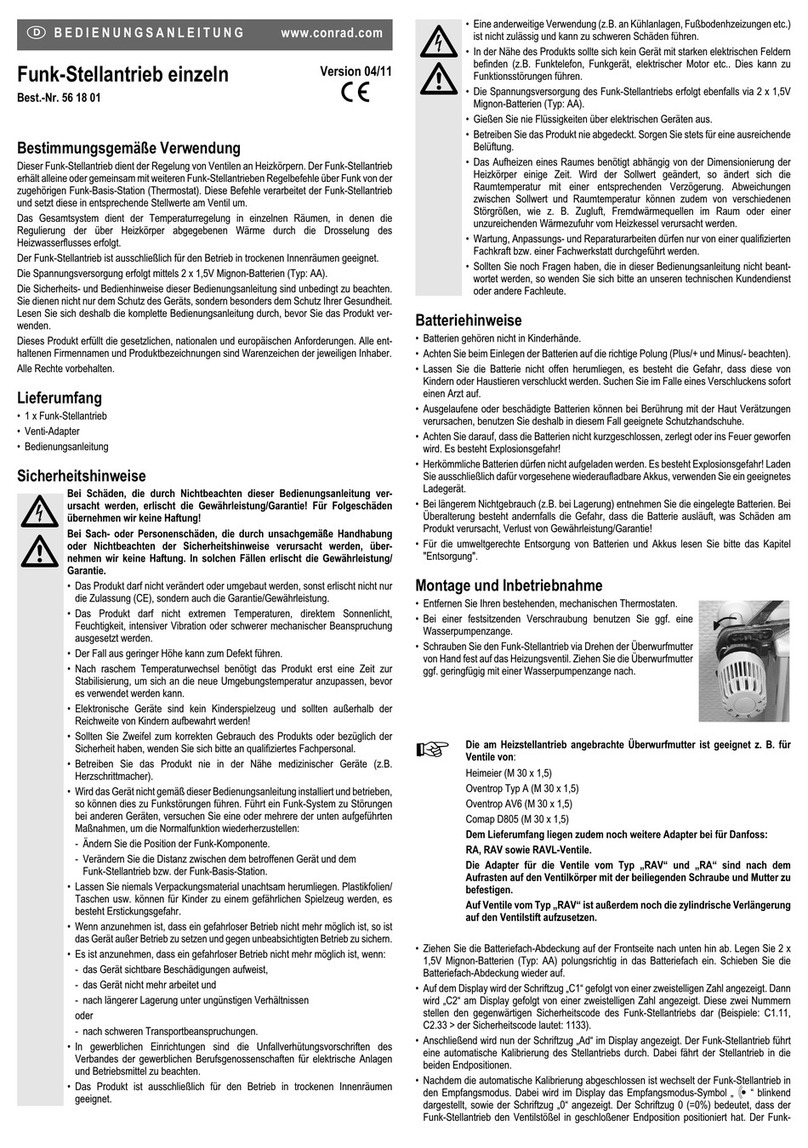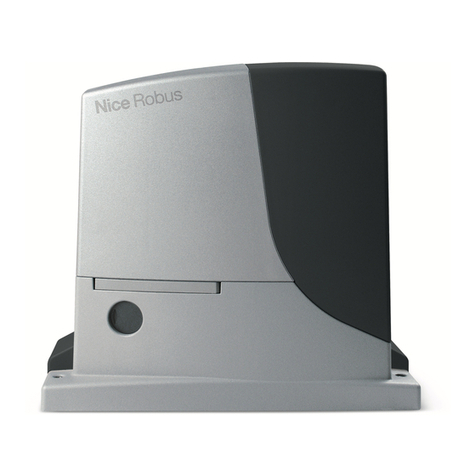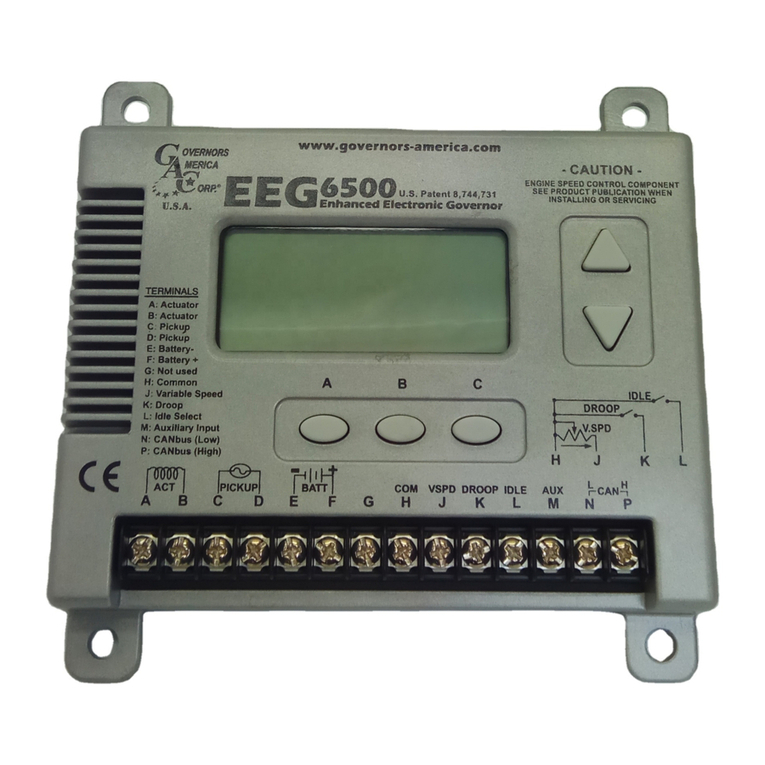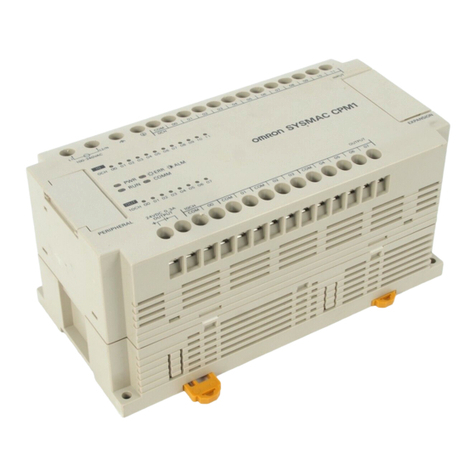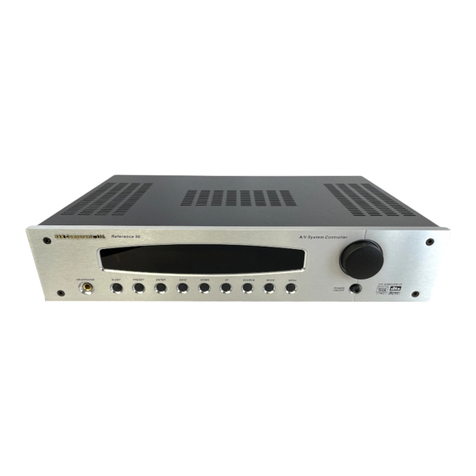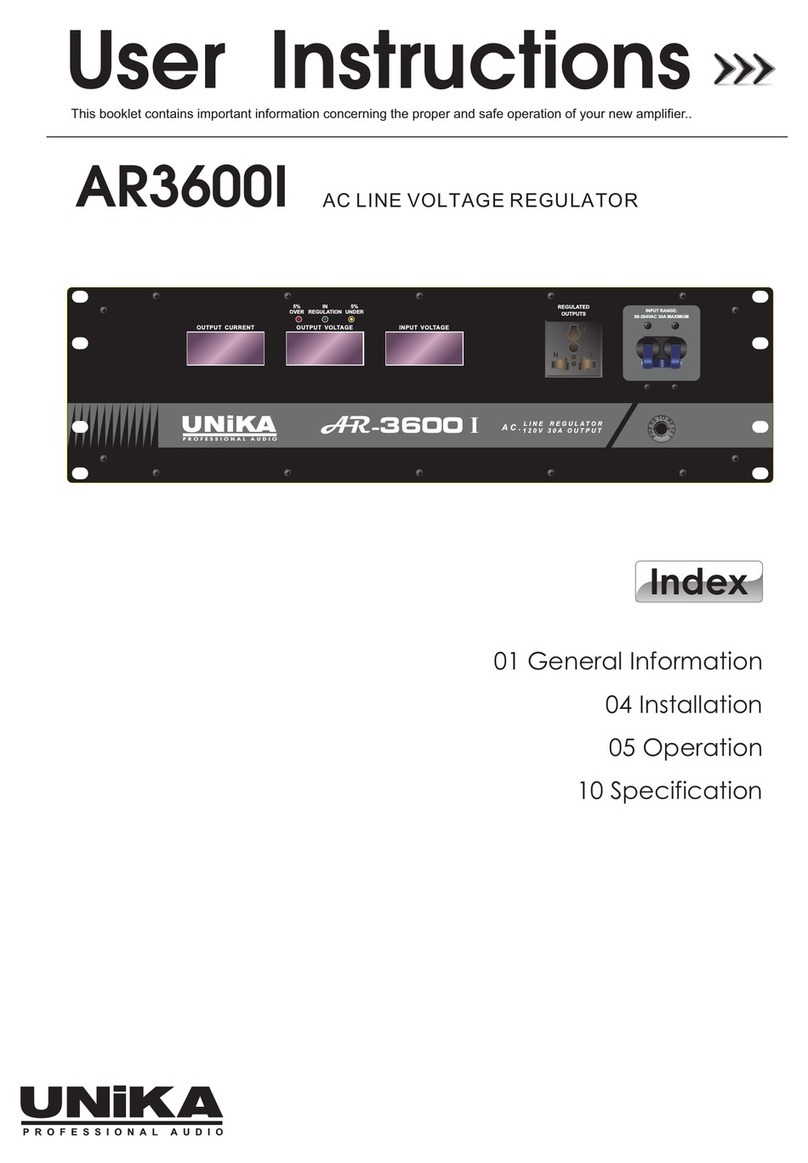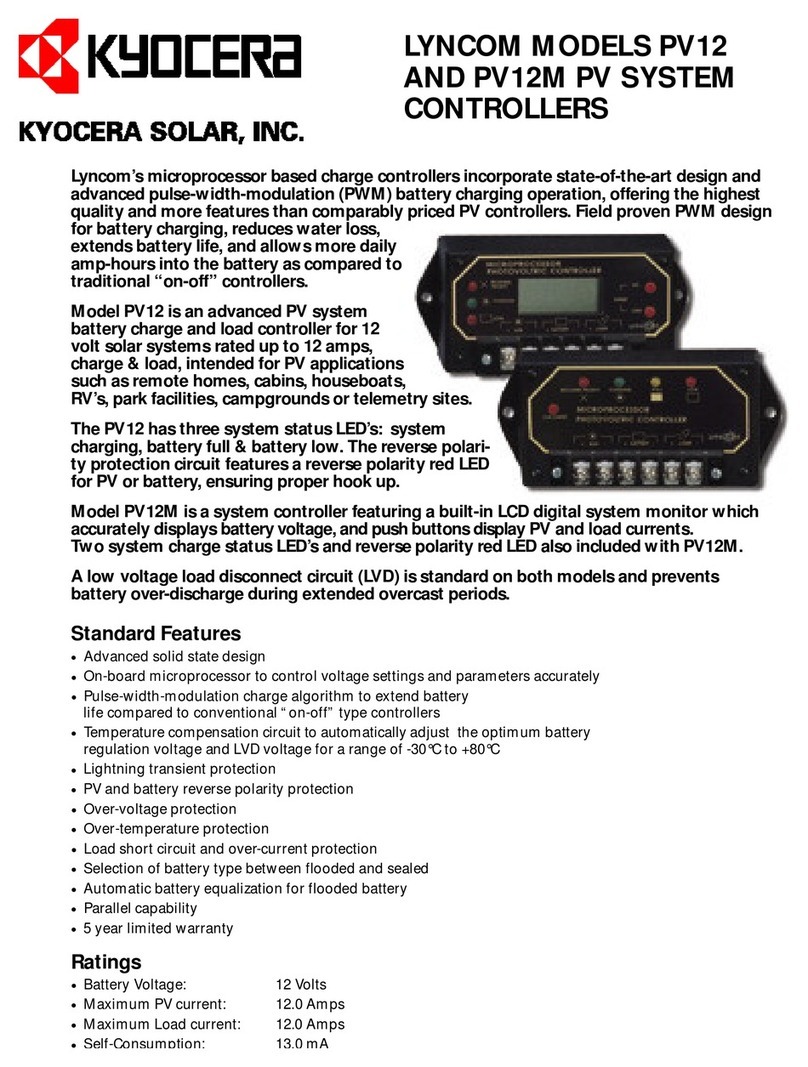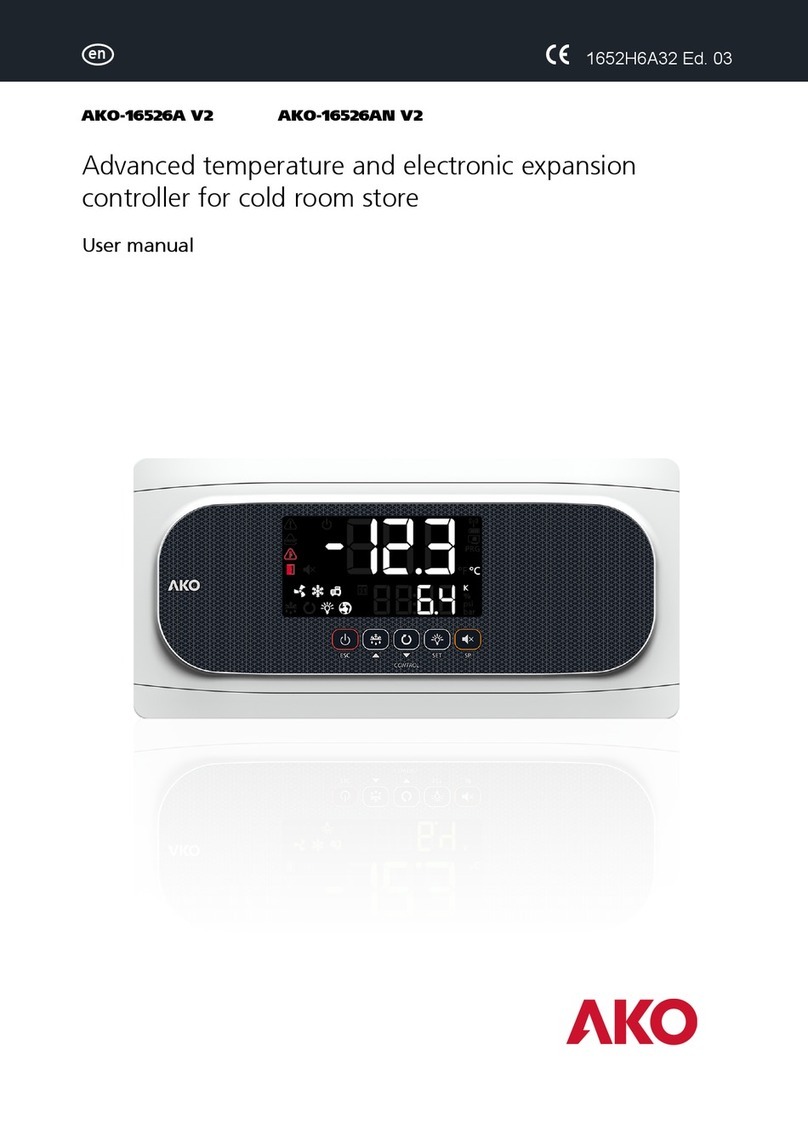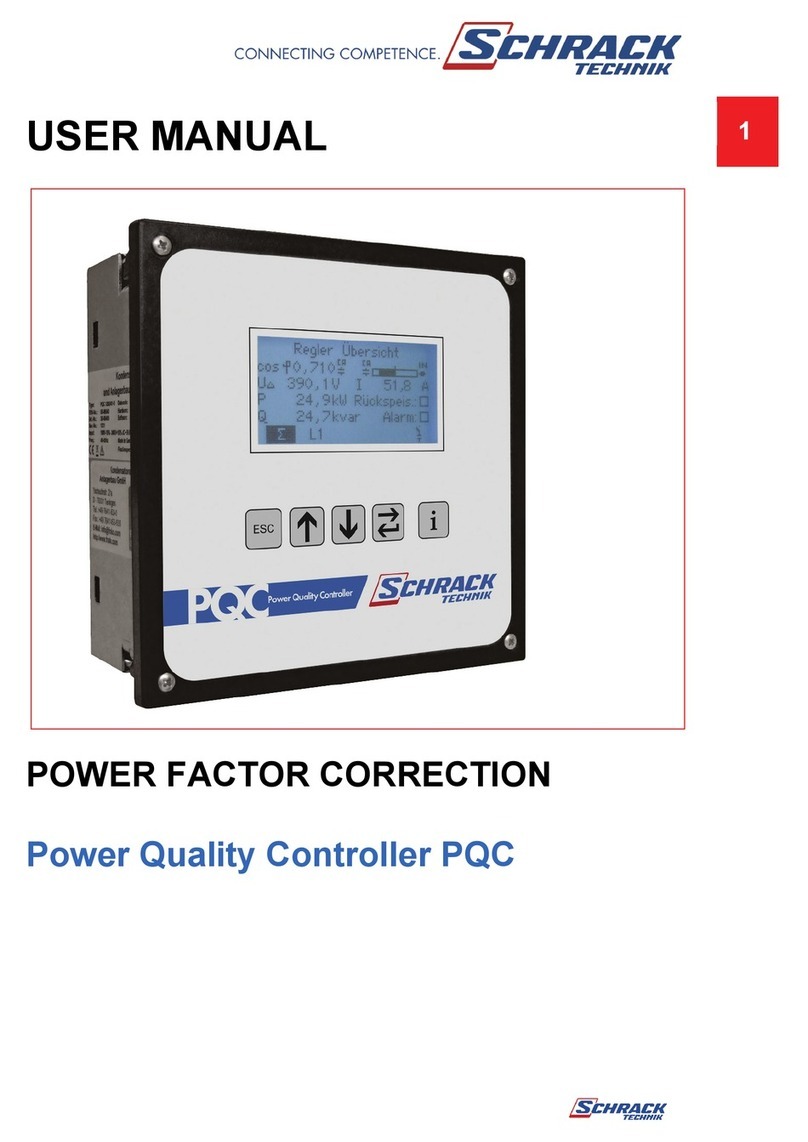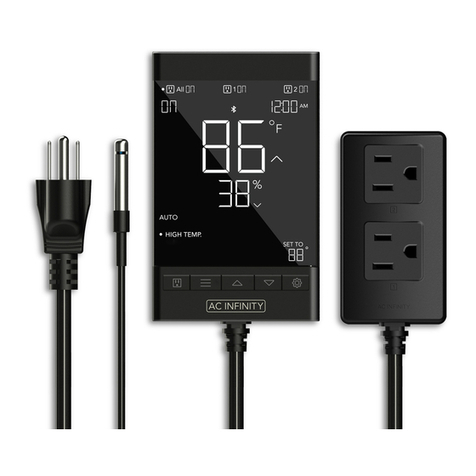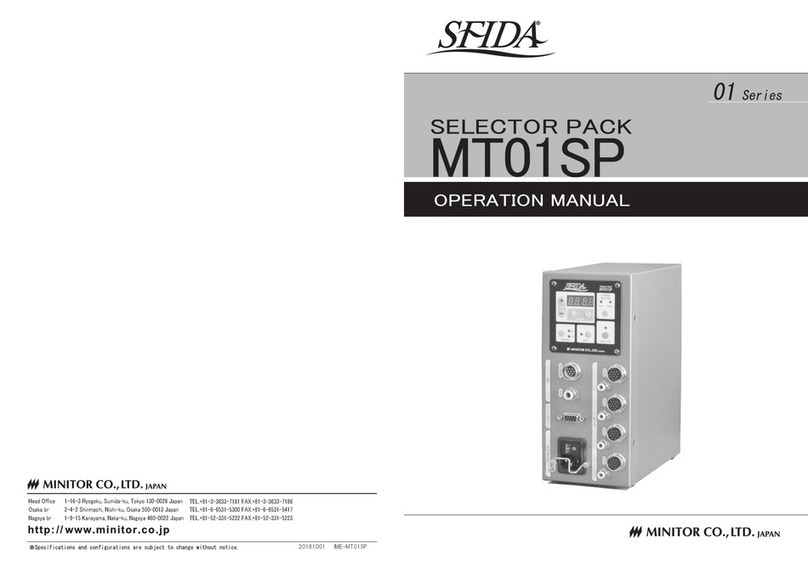AUMA SA 07.1 User manual

Multi-turn actuator
SA 07.1 – SA 16.1/SAR 07.1 – SAR 16.1
Intrusive
with actuator controls
AUMATIC AC 01.1
Operation instructions Assembly, operation, commissioning
Control:
àParallel
Profibus DP
Profibus DP with FO
Modbus
Modbus with FO
DeviceNet
Foundation Fieldbus

Table of contents Page
1. Safety instructions . . . . . . . . . . . . . . . . . . . . . . . . . . . . . . . . . . . 5
1.1. General notes on safety 5
1.2. Range of application 6
1.3. Applications in Ex zone 22 (option) 7
1.4. Warnings and notes 8
1.5. Further references and symbols 8
2. Identification. . . . . . . . . . . . . . . . . . . . . . . . . . . . . . . . . . . . . . . 9
2.1. Name plate 9
2.2. Short description 11
3. Transport, storage and packaging . . . . . . . . . . . . . . . . . . . . . . . . . . 12
3.1. Transport 12
3.2. Storage 12
3.3. Packaging 12
4. Assembly . . . . . . . . . . . . . . . . . . . . . . . . . . . . . . . . . . . . . . . .13
4.1. Handwheel fitting 13
4.2. Multi-turn actuator mounting to valve/gearbox 14
4.2.1 Output drive types B1, B2, B3, B4, B, and E 14
4.2.2 Output drive type A 15
4.3. Accessories (option) 17
4.3.1 Protection tube for rising valve stem 17
4.4. Mounting positions of the local controls 18
5. Electrical connection . . . . . . . . . . . . . . . . . . . . . . . . . . . . . . . . . 19
5.1. General notes 19
5.2. Connection with AUMA plug/socket connector (S, SH, SE) 20
5.3. Accessories for electrical connection (option) 23
5.3.1 Controls mounted to wall bracket 23
5.3.2 Parking frame 24
5.3.3 Protection cover 24
5.3.4 Double sealed intermediate frame 24
5.3.5 Ground connection, external 24
6. Operation . . . . . . . . . . . . . . . . . . . . . . . . . . . . . . . . . . . . . . . .25
6.1. Manual operation 25
6.2. Motor operation 26
6.2.1 Local operation 26
6.2.2 Operation from REMOTE: 26
6.3. Menu navigation via push buttons (for settings and indications) 27
6.3.1 Short overview: functions of the push buttons 27
6.3.2 Structural design and navigation 28
6.4. Language change in the display 29
2
Multi-turn actuator SA 07.1 – SA 16.1/SAR 07.1 – SAR 16.1 Intrusive
with actuator controls AUMATIC AC 01.1 Operation instructions
Read the operation instructions first
.Observe safety instructions.
.These operation instructions are part of the product.
.Store operation instructions during product life.
.Pass on instructions to any subsequent user or owner of the product.
Reference documents:
.Manual (Operation and setting) AUMATIC AC 01.1.
Can be downloaded from the Internet (www.auma.com) or ordered directly from AUMA
(addresses from page 70).

Page
7. Indications . . . . . . . . . . . . . . . . . . . . . . . . . . . . . . . . . . . . . . .31
7.1. Status indication in the display 31
7.1.1 Status indication S0/S6 - operation 31
7.2. Indication lights/LEDs 32
7.3. Mechanical position indicator/running indication (option) 32
8. Signals . . . . . . . . . . . . . . . . . . . . . . . . . . . . . . . . . . . . . . . . . 33
8.1. Feedback via output contacts (binary) 33
8.2. Feedback signals (analogue) – (option) 33
9. Commissioning . . . . . . . . . . . . . . . . . . . . . . . . . . . . . . . . . . . . 34
9.1. Type of seating: check/edit for end positions 35
9.2. Switch compartment: open 38
9.3. Torque switching: check/set 39
9.4. Limit switching setting 40
9.4.1 End position CLOSED (black section) setting 40
9.4.2 End position OPEN (white section) setting 40
9.5. Intermediate positions (option) setting 41
9.5.1 Running direction CLOSE (black section) setting 41
9.5.2 Running direction OPEN (white section) setting 41
9.6. Test run 42
9.6.1 Rotational direction check 42
9.6.2 Limit switching check 43
9.6.3 Perform reference operation 43
9.7. Potentiometer (option) setting 44
9.8. Electronic position transmitter RWG setting (option) 45
9.9. Mechanical position indicator setting (option) 46
9.10. Switch compartment: close 47
10. Corrective action . . . . . . . . . . . . . . . . . . . . . . . . . . . . . . . . . . . . 48
10.1. Faults during commissioning 48
10.1.1 Mechanical position indicator 48
10.1.2 Position transmitter RWG 48
10.1.3 Limit and torque switches 48
10.1.4 Fault in end position (overrun not considered) 49
10.1.5 Push buttons do not react 49
10.2. Fault indications and warning indications 50
10.2.1 Status display S0 - faults and warnings 50
10.2.2 Status indication S1 - faults 51
10.2.3 Status indication S2 - warnings 52
10.2.4 Status indication S3 - causes for not ready remote 53
10.3. Fuses 54
10.3.1 Fuses within the actuator controls 54
10.3.2 Motor protection (thermal monitoring) 55
11. Servicing and maintenance . . . . . . . . . . . . . . . . . . . . . . . . . . . . . . 56
11.1. Preventive measures for servicing and safe operation 56
11.2. Maintenance 57
11.3. Disposal and recycling 57
3
Multi-turn actuator SA 07.1 – SA 16.1/SAR 07.1 – SAR 16.1 Intrusive
Operation instructions with actuator controls AUMATIC AC 01.1

Page
12. Spare parts list . . . . . . . . . . . . . . . . . . . . . . . . . . . . . . . . . . . . .58
12.1. Multi-turn actuator SA 07.1 – SA 16.1/SAR 07.1 – SAR 16.1 58
12.2. Controls AC 01.1 with AUMA plug/socket connector (S, SH, SE) 60
13. Technical data . . . . . . . . . . . . . . . . . . . . . . . . . . . . . . . . . . . . . 62
14. Certificates . . . . . . . . . . . . . . . . . . . . . . . . . . . . . . . . . . . . . . . 68
14.1. Declaration of Conformity and Declaration of Incorporation 68
Index . . . . . . . . . . . . . . . . . . . . . . . . . . . . . . . . . . . . . . . . . .69
Addresses . . . . . . . . . . . . . . . . . . . . . . . . . . . . . . . . . . . . . . . 70
4
Multi-turn actuator SA 07.1 – SA 16.1/SAR 07.1 – SAR 16.1 Intrusive
with actuator controls AUMATIC AC 01.1 Operation instructions

1. Safety instructions
1.1. General notes on safety
5
Multi-turn actuator SA 07.1 – SA 16.1/SAR 07.1 – SAR 16.1 Intrusive
Operation instructions with actuator controls AUMATIC AC 01.1
Standards/directives AUMA products are designed and manufactured in compliance with recog-
nised standards and directives. This is certified in a declaration of incorpora-
tion and a declaration of conformity.
The end user or the contractor must ensure that all requirements with
respect to assembly, electrical connection, and commissioning at the place
of installation are met. They include among others:
.National regulations, laws, and prescriptions.
Safety instructions/
warnings
All personnel working with this device must be familiar with the safety and
warning instructions in this manual and observe the instructions given.
Safety instructions and warning signs on the device must be observed to
avoid personal injury or property damage.
Qualification of staff Assembly, electrical connection, commissioning, operation, and mainte-
nance must be carried out exclusively by suitably qualified personnel having
been authorised by the end user or contractor of the plant.
Prior to working on this product, the staff must have thoroughly read and
understood these instructions and, furthermore, know and observe officially
recognised rules regarding occupational health and safety.
Commissioning Prior to commissioning, it is important to check that all settings are in com-
pliance with the requirements of the application. Incorrect settings might
present a danger to the application, e.g. cause damage to the valve or the
installation.
The manufacturer will not be held liable for any consequential damage. Such
risk lies entirely with the user.
Operation Prerequisites for safe and smooth operation:
.Correct transport, proper storage, mounting and installation, as well as
careful commissioning.
.Only operate the device if it is in perfect condition while observing these
instructions.
.Immediately notify any faults and damage and allow for corrective mea-
sures.
.Observe recognised rules for occupational health and safety.
.Observe the national regulations.
.During operation, the housing warms up and surface temperatures > 60 °C
may occur. To prevent possible burns, we recommend to the check surface
temperature with an appropriate thermometer prior to working with the device.
Protective measures The end user or the contractor are responsible for implementing required
protective measures on site, such as enclosures, barriers, or personal
safety equipment for the staff.
Maintenance To ensure safe device operation, the maintenance instructions included in
this manual must be observed.
Any device modification requires the consent of the manufacturer.

1.2. Range of application
6
Multi-turn actuator SA 07.1 – SA 16.1/SAR 07.1 – SAR 16.1 Intrusive
with actuator controls AUMATIC AC 01.1 Operation instructions
AUMA multi-turn actuators are designed for the operation of industrial
valves, e.g. globe valves, gate valves, butterfly valves, and ball valves.
Other applications require explicit (written) confirmation by the manufacturer.
The following applications are not permitted, e.g.:
.Industrial trucks according to EN ISO 3691
.Lifting appliances according to EN 14502
.Passenger lifts according to DIN 15306 and 15309
.Service lifts according to EN 81-1/A1
.Roller conveyors according to Standard EN 14673 (draft)
.Permanent operation
.Buried service
.Permanent submersion (observe enclosure protection)
.Potentially explosive areas, with the exception of zone 22
.Radiation exposed areas in nuclear power plants
No liability can be assumed for inappropriate or unintended use.
Observance of these operation instructions is considered as part of the
device’s designated use.
Information These operation instructions are only valid for the “clockwise closing” stan-
dard version, i.e. driven shaft turns clockwise to close the valve. Separate
instructions are available for the “counterclockwise closing” special version.

1.3. Applications in Ex zone 22 (option)
SA 07.1 – SA 16.1/SAR 07.1 – SAR 16.1 actuators basically meet the
requirements for applications in dust hazardous locations of ZONE 22, in
compliance with the ATEX directive 94/9/EC.
The actuators are designed to meet enclosure protection IP 67 or IP 68 and
fulfil the requirements of EN 50281-1-1:1998 section 6 – Electrical appara-
tus for use in presence of combustible dust hazards, requirements for cate-
gory 3 electrical equipment – protected by enclosures.
To comply with all requirements of EN 50281-1-1: 1998, the following points
must imperatively be observed:
.In compliance with the ATEX directive 94/9/EC, the actuators must be
equipped with an additional identification – II3D IP6X T150 °C.
.The maximum surface temperature of the actuators, based on an ambi-
ent temperature of +40 °C in accordance with EN 50281-1-1 section
10.4, is +150 °C. In accordance with section 10.4, an increased dust
deposit on the equipment was not considered for the determination of
the max. surface temperature.
.The correct connection of the thermoswitches or the PTC thermistors as
well as fulfilling the requirements of the duty type and the technical data
are prerequisites for compliance with the maximum surface temperature
of devices.
.The connection plug may only be plugged in or pulled out when device is
disconnected from the mains.
.The cable glands used also have to meet the requirements of category
II3 D and must at least comply with enclosure protection IP 67.
.The actuators must be connected by means of an external ground con-
nection (accessory part) to the potential equaliser or integrated into a
grounded piping system.
.The screw plug (part no. 511.0) or the stem protection tube with protec-
tion cap (part nos. 568.1 and 568.2) for sealing the hollow shaft must
imperatively be mounted to guarantee the combustible dust hazard
protection.
.As a general rule, the requirements of EN 50281-1-1 must be respected
in dust hazardous locations. During commissioning, service, and mainte-
nance, special care as well as qualified and trained personnel are
required for the safe operation of actuators.
7
Multi-turn actuator SA 07.1 – SA 16.1/SAR 07.1 – SAR 16.1 Intrusive
Operation instructions with actuator controls AUMATIC AC 01.1

1.4. Warnings and notes
The following warnings draw special attention to safety-relevant procedures
in these operation instructions, each marked by the appropriate signal word
(DANGER, WARNING, CAUTION, NOTICE).
Indicates an imminently hazardous situation with a high level of risk.
Failure to observe this warning will result in death or serious injury.
Indicates a potentially hazardous situation with a medium level of risk.
Failure to observe this warning could result in death or serious injury.
Indicates a potentially hazardous situation with a low level of risk.
Failure to observe this warning may result in minor or moderate injury. May
also be used with property damage.
Potentially hazardous situation.
Failure to observe this warning may result in property damage. Is not used
for personal injury.
Arrangement and typographic structure of the warnings
Safety alert symbol (warns of a potential personal injury hazard).
Signal word (DANGER, WARNING, CAUTION, NOTE)
1.5. Further references and symbols
The following references and symbols are used in these instructions:
Information The term Information preceding the text indicates important notes and
information.
Symbol for CLOSED.
Symbol for OPEN.
ÆVia the menu to parameter
Describes the path within the menu to the parameter. By using the push but-
tons of the local controls you may quickly find the desired parameter in the
display.
ÈDescription of the parameter settings/indications
Describes the setting/viewing possibilities of a parameter.
òStep by step
Provides a detailed description of each step for setting/viewing the parame-
ter.
8
Multi-turn actuator SA 07.1 – SA 16.1/SAR 07.1 – SAR 16.1 Intrusive
with actuator controls AUMATIC AC 01.1 Operation instructions
Type of hazard and respective source!
Possible consequence(s) in case of non-observance (option)
ÒMeasures to avoid the danger
ÒFurther measure(s)
DANGER
CAUTION
WARNING
NOTICE
DANGER

2. Identification
2.1. Name plate
Each device (actuator, controls, motor) is equipped with a name plate.
Figure 1 shows the arrangement of name plates on the device.
Identification data on the actuator name plate:
Identification data on the controls’ name plate:
9
Multi-turn actuator SA 07.1 – SA 16.1/SAR 07.1 – SAR 16.1 Intrusive
Operation instructions with actuator controls AUMATIC AC 01.1
Figure 1
1 Actuator name plate 3 Motor name plate
2 Controls name plate 4 Additional plate, e.g. KKS plate
1 Type and size of actuator
2 Commission number
1 Type and size of the controls
2 Commission number
3 Wiring diagram/control
aCC
AUMA Riester GmbH&Co.KG
D-79379 Müllheim
No : 3302MD 19302
SA 07.1-
Com No: 1309533
F10
1
2
Figure 2
auma
AC 01.1
Com No: 1309595
ACP C:
P:1,5kW
No: 0902MA97286
KMS: TP180/001
11F1-2P0 A 002
3 ~ 400V IP67
Control: 24V DC
-
1
2
3
Figure 3

Type and size These instructions apply to the following actuator controls combinations:
Type: SA = multi-turn actuator for open-close duty
Type: SAR= multi-turn actuator for modulating duty
Size: 07.1 – 16.1
Type: AC = AUMATIC AC actuator controls
Size: 01.1
Commission number An order-specific commission number is assigned to each device. You can
use this commission number to download the wiring diagram, inspection
records and further information for the device from the Internet
(http://www.auma.com).
Wiring diagram/control Controlling the actuator controls is performed via a parallel interface, if the
9th position in the ACP wiring diagram contains the character A, B, C, or 1,
e.g.: ACP 11F1-2P0CA-002.
10
Multi-turn actuator SA 07.1 – SA 16.1/SAR 07.1 – SAR 16.1 Intrusive
with actuator controls AUMATIC AC 01.1 Operation instructions

2.2. Short description
Multi-turn actuator Definition in compliance with EN ISO 5210:
A multi-turn actuator is an actuator which transmits to the valve a torque for
at least one full revolution. It is capable of withstanding thrust.
AUMA multi-turn actuators are driven by an electric motor. A handwheel is
provided for manual operation.
Switching off in end positions may be either by limit or torque seating.
Controls are required to operate or process the actuator signals.
Actuator controls The AUMATIC actuator controls is used to operate AUMA actuators and is
supplied ready for use.
The controls can be mounted directly to the actuator but also separately on
a wall bracket.
The functions of the AUMATIC controls include standard valve control in
OPEN - CLOSE duty, positioning, process control, logging of operating data
right through to diagnosis functions.
Local controls/
COM-AC
Operation, setting, and display can be performed on site directly at the
controls
On site it is possible to
.operate the actuator via the local controls (push buttons and display)
and perform settings (contents of these instructions).
.read in or out data or modify and save settings via the COM-AC software
(option), using a computer (laptop or PC). Depending on the version, the
connection between computer and AUMATIC can be made with cable
(infra-red interface) or without cable (Bluetooth interface) (not included in
these instructions).
Intrusive – Non-Intrusive .Intrusive version:
Limit and torque setting is performed via switches in the actuator.
.Non-Intrusive version:
Limit and torque setting is performed via the controls, actuator and con-
trols housings do not have to be opened.
For this purpose, the actuator is equipped with an MWG (magnetic limit
and torque transmitter), also supplying analogue torque feedback sig-
nals/torque indication.
11
Multi-turn actuator SA 07.1 – SA 16.1/SAR 07.1 – SAR 16.1 Intrusive
Operation instructions with actuator controls AUMATIC AC 01.1

3. Transport, storage and packaging
3.1. Transport
ÒFor transport to place of installation, use sturdy packaging.
3.2. Storage
Long-term storage: If the device must be stored for a long period (more than 6 months) the fol-
lowing points must be observed in addition:
1. Prior to storage:
ÒProtect uncoated surfaces, in particular the output drive parts and
mounting surface, with long-term corrosion protection agent.
2. At an interval of approx. 6 months:
ÒCheck for corrosion. If first signs of corrosion show, apply new corrosion
protection.
3.3. Packaging
Our products are protected by special packaging for the transport ex works.
The packaging consists of environmentally friendly materials which can eas-
ily be separated and recycled.
We use the following packaging materials: wood, cardboard, paper, and PE
foil. For the disposal of the packaging material, we recommend recycling
and collection centres.
12
Multi-turn actuator SA 07.1 – SA 16.1/SAR 07.1 – SAR 16.1 Intrusive
with actuator controls AUMATIC AC 01.1 Operation instructions
Danger of corrosion due to inappropriate storage!
ÒStore in a well-ventilated, dry room.
ÒProtect against floor dampness by storage on a shelf or on a wooden
pallet.
ÒCover to protect against dust and dirt.
ÒApply suitable corrosion protection agent to uncoated surfaces.
NOTICE
Hovering load!
Death or serious injury possible.
ÒDo not place below hovering load.
ÒAttach ropes or hooks for the purpose of lifting by hoist only to housing
and not to handwheel.
ÒActuators mounted on valves:
Attach ropes or hooks for the purpose of lifting by hoist to valve and not
to multi-turn actuator.
ÒActuators mounted to gearboxes:
Attach ropes or hooks for the purpose of lifting by hoist only to the gear-
box using eyebolts and not to the actuator
ÒActuators mounted to controls:
Attach ropes or hooks for the purpose of lifting by hoist only to actuator
and not to controls.
DANGER

4. Assembly
4.1. Handwheel fitting
Information For transport purposes, handwheels from a diameter of 400 mm are sup-
plied separately.
1. Manually lift the red change-over lever while slightly turning the shaft
back and forth until manual operation engages.
The manual operation is correctly engaged if the change-over lever can
be lifted by approx. 85°.
2. Attach handwheel over the red change-over lever then on to the shaft.
3. Secure handwheel using the circlip supplied.
13
Multi-turn actuator SA 07.1 – SA 16.1/SAR 07.1 – SAR 16.1 Intrusive
Operation instructions with actuator controls AUMATIC AC 01.1
85°
Damage at the change-over mechanism due to incorrect assembly!
ÒOnly pivot the change-over lever manually.
ÒUsing extensions as a lever for operation is not permitted.
ÒFirst engage manual operation correctly, then mount handwheel.
NOTICE

4.2. Multi-turn actuator mounting to valve/gearbox
4.2.1 Output drive types B1, B2, B3, B4, B, and E
Application For rotating, non-rising valve stem.
Design Output drive type bore with keyway:
Type B1 – B4 with bore according to ISO 5210.
Type B and E with bore according to DIN 3210.
Later change from B1 to B3, B4, or E is possible.
Information Spigot at flanges should be loose fit.
Mounting the multi-turn actuator
1. Check if mounting flanges fit together.
2. Check whether bore and keyway match the input shaft.
3. Thoroughly degrease mounting faces of the mounting flanges.
4. Apply a small quantity of grease to the input shaft.
5. Mount multi-turn actuator and ensure that the spigot mates uniformly in
the recess and that the mounting faces are in complete contact.
6. Fasten multi-turn actuator with screws according to table 1.
7. Fasten screws crosswise with a torque according to table 1.
14
Multi-turn actuator SA 07.1 – SA 16.1/SAR 07.1 – SAR 16.1 Intrusive
with actuator controls AUMATIC AC 01.1 Operation instructions
2
13
4
Figure 4
1 Output drive type B1/B2 and B 3 Output drive B3/B4 and E
2 Hollow shaft with keyway 4 Plug sleeve
with bore and keyway
Mounting flange Screws
Thread
Fastening torque TA[Nm]
Strength class 8.8
F07 M8 25
F10 M10 51
F14 M12 87
F16 M16 214
Table 1
Danger of corrosion due to damage to paint finish and condensation!
ÒTouch up damage to paint finish after working on the device.
ÒAfter mounting, connect the device immediately to electrical mains to
ensure that heater reduces condensation.
NOTICE

4.2.2 Output drive type A
Application .For rising, non-rotating valve stem.
.Capable of withstanding thrust
Design Output drive type A as separate unit (figure 5):
.The internal thread of the stem nut must match the thread of the valve
stem.
.If not ordered explicitly with thread, the stem nut is supplied unbored or
with a pilot bore.
Finish machining the stem nut
Only required for stem nut if supplied unbored or with a pilot bore.
1. Remove spigot ring (3) from output drive type.
2. Take off stem nut (1) together with axial needle roller and cage assembly
(2) and axial bearing washers (4).
3. Remove axial needle roller and cage assembly and axial bearing wash-
ers from stem nut.
4. Drill and bore stem nut and cut thread.
When fixing in the chuck, make sure stem nut runs true!
5. Clean the machined stem nut.
6. Apply Lithium soap EP multi-purpose grease to axial needle roller and
cage assembly and axial bearing washers, then place them on stem nut.
7. Re-insert stem nut with axial bearings into output drive type. Ensure that
dogs or toothing are placed correctly in the slots of the hollow shaft.
8. Screw in spigot ring until it is firm against the shoulder.
9. Press in Lithium soap EP multi-purpose grease on mineral oil base at the
grease nipple with a grease gun (for quantities, please refer to table 2).
Grease quantities for bearing of output drive A:
15
Multi-turn actuator SA 07.1 – SA 16.1/SAR 07.1 – SAR 16.1 Intrusive
Operation instructions with actuator controls AUMATIC AC 01.1
1
3
2
24
4
Figure 5
1 Stem nut 3 Spigot ring
2 Axial needle roller and cage assembly 4 Axial bearing washer
Output drive A 07.2 A 10.2 A 14.2 A 16.2
Qty1) 1.5 g 2 g 3 g 5 g
1) For grease with density ρ= 0.9 kg/dm³
Table 2

Mounting the multi-turn actuator (with output drive A) to valve
1. Remove screws (3) and take off output drive type A (2) from multi-turn
actuator.
2. Check if the flange of output drive type A matches the valve flange (4).
3. Thoroughly degrease mounting faces of the mounting flanges.
4. Apply a small quantity of grease to the valve stem (1).
5. Place output drive type A on valve stem and fasten until it is seated sol-
idly on the valve flange.
6. Turn output drive type A until alignment of the fastening holes.
7. Screw in fastening screws (5), however do not completely fasten.
8. Fit multi-turn actuator on the valve stem so that the hollow shaft pinions
engage into the stem nut. The flanges are flush with each other if prop-
erly engaged.
9. Turn multi-turn actuator until alignment of the fastening holes.
10 Fasten multi-turn actuator with screws (3) according to table 1, page 14.
11. Fasten screws crosswise with a torque according to table 1.
12. Engage manual operation at multi-turn actuator and turn handwheel in
direction OPEN until valve flange and output drive type A are firmly
placed together.
13. Tighten fastening screws (5) between valve and output drive type A
crosswise with a torque according to table 1, page 14.
16
Multi-turn actuator SA 07.1 – SA 16.1/SAR 07.1 – SAR 16.1 Intrusive
with actuator controls AUMATIC AC 01.1 Operation instructions
Figure 6
1 Valve stem 4 Valve flange
2 Output drive type A 5 Screws to output drive
3 Screw to actuator
Danger of corrosion due to damage to paint finish and condensation!
ÒTouch up damage to paint finish after working on the device.
ÒAfter mounting, connect the device immediately to electrical mains to
ensure that heater reduces condensation.
NOTICE

4.3. Accessories (option)
4.3.1 Protection tube for rising valve stem
1. Seal thread with hemp, Teflon tape, or thread sealing material.
2. Screw protection tube (2) into thread and tighten it firmly.
3. Push down the sealing ring (3) into the housing.
4. Check whether cap (1) is available and in perfect condition.
17
Multi-turn actuator SA 07.1 – SA 16.1/SAR 07.1 – SAR 16.1 Intrusive
Operation instructions with actuator controls AUMATIC AC 01.1
3
2
1
Figure 7
1 Cap for stem protection tube 3 Sealing ring
2 Stem protection tube

4.4. Mounting positions of the local controls
The mounting position of the local controls is designed according to the
order. If, after mounting the actuator to the valve or the gearbox on site, the
local controls is in an unfavourable position, the mounting position can be
changed at a later date. Four mounting positions are possible.
Figure 8 shows mounting positions A and B:
Figure 9 shows mounting positions C and D:
Changing the mounting position
1. Loosen bolts and remove the local controls.
2. Check whether O-ring is in good condition, correctly place O-ring.
3. Turn local controls into new position and re-place.
4. Fasten bolts evenly crosswise.
18
Multi-turn actuator SA 07.1 – SA 16.1/SAR 07.1 – SAR 16.1 Intrusive
with actuator controls AUMATIC AC 01.1 Operation instructions
Figure 8
Figure 9
Hazardous voltage!
Electric shock possible.
ÒDisconnect device from the mains before opening.
Cable damage due to twisting or squeezing!
Functional failures possible.
ÒTurn local controls by a maximum of 180°.
ÒCarefully assemble local controls to avoid pinching the cables.
DANGER
NOTICE

5. Electrical connection
5.1. General notes
19
Multi-turn actuator SA 07.1 – SA 16.1/SAR 07.1 – SAR 16.1 Intrusive
Operation instructions with actuator controls AUMATIC AC 01.1
Wiring diagram/terminal plan The wiring diagram/terminal plan is attached to the device in a
weather-proof bag, together with these operation instructions. It can also be
obtained from AUMA (state commission no., refer to name plate) or down-
loaded directly from the Internet (www.auma.com).
Danger due to incorrect electrical connection!
Failure to observe this warning can result in death, serious injury, or prop-
erty damage.
ÒThe electrical connection must be carried out exclusively by suitably
qualified personnel.
ÒPrior to connection, observe general references contained in this clause.
Protection on site For short-circuit protection and for disconnecting the actuator from the
mains, fuses and disconnect switches have to be provided by the customer.
The current values for respective sizing can be derived from the current
consumption of the motor plus the current consumption of the controls.
Motor current consumption:
Refer to name plate on motor (nominal current).
Current consumption of the controls depending on the mains voltage:
100 to 120 V AC = max. 650 mA
208 to 240 V AC = max. 325 mA
380 to 500 V AC = max. 190 mA
24 V DC (+10 %/–15 %) = max. 500 mA, filter capacitor 2200 µF
Current consumption for actuator with 1-ph DC motor:
24 V DC (+10 %/–10 %) = max. 750 mA, filter capacitor 2200 µF
The maximum permissible fuse for controls with a rated power of 1.5 kW is
16 A (gL/gG); for controls with a rated power of 7.5 kW, the value amounts
to 32 A (gL/gG).
WARNING
Power supply for the controls
(electronics)
If the controls (electronics) are supplied externally with 24 V DC and DC
motors (24 V DC, 48 V DC, 60 V DC, 110 V DC, 220 V DC) are used simul-
taneously, the 24 V DC voltage supply for the controls should be ensured
via the XK25/26 terminals, separate from the power supply (U1, V1). In case
of common supply using a single cable (links from U1, V1 with XK25/26, for
24 V DC only !!!), short-term excess or falling below the admissible voltage
limits can be the consequence during switching (24 V DC +10 %/–10 %).
Any possibly incoming operation commands are not executed outside the
admissible limit values. The controls briefly signal a fault condition.
Cable installation in accordance
with EMC
Signal and bus cables are susceptible to interference.
Motor cables are interference sources.
.Lay cables being susceptible to interference or sources of interference at
the highest possible distance from each other.
.The interference immunity of signal and bus cables increases if the
cables are laid close to the ground potential.
.If possible, avoid laying long cables and make sure that they are
installed in areas being subject to low interference.
.Avoid long parallel paths with cables being either susceptible to interfer-
ence or interference sources.
.For the connection of remote position transmitters (potentiometer, RWG,
MWG), screened cables must be used.

5.2. Connection with AUMA plug/socket connector (S, SH, SE)
Before mains connection
ÒCheck whether type of current, supply voltage, and frequency comply
with motor data (refer to name plate at motor).
Opening the terminal compartment
Figure 10 shows the connection using the example of version S:
1. Loosen screws (2) and remove cover (1).
2. Loosen screws (4) and remove socket carrier (5) from cover (1).
3. Insert cable glands (8) suitable for connecting cables.
The enclosure protection IP… stated on the name plate is only ensured
if suitable cable glands are used.
4. Seal cable entries (6) which are not used with suitable screw plugs (7).
5. Insert the wires into the cable glands (8).
20
Multi-turn actuator SA 07.1 – SA 16.1/SAR 07.1 – SAR 16.1 Intrusive
with actuator controls AUMATIC AC 01.1 Operation instructions
aCC
VD00 63-4/45
Art Nr: Z006.413
0.090 kW
Y 0.60 A
3 ~ 400 V 50 Hz
Hazardous voltage!
Electric shock possible.
ÒDisconnect device from the mains before opening.
3
1
2
5
7
4
6
8
Figure 10
1 Cover 5 Socket carrier
2 Screws for cover 6 Cable entry
3 O-ring 7 Screw plugs
4 Screws for socket carrier 8 Cable gland (not included in delivery)
au
IP 67
1680 1/min
Temp.Schutz: Th
Isol.Kl: F
DANGER
Other manuals for SA 07.1
3
This manual suits for next models
3
Table of contents
Other AUMA Controllers manuals

AUMA
AUMA PROFOX PF-M100X User manual
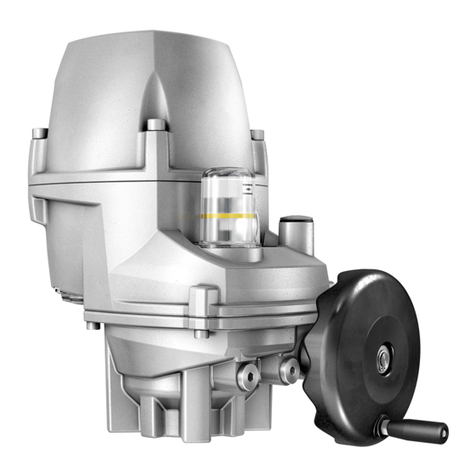
AUMA
AUMA PROFOX PF-M25X User manual
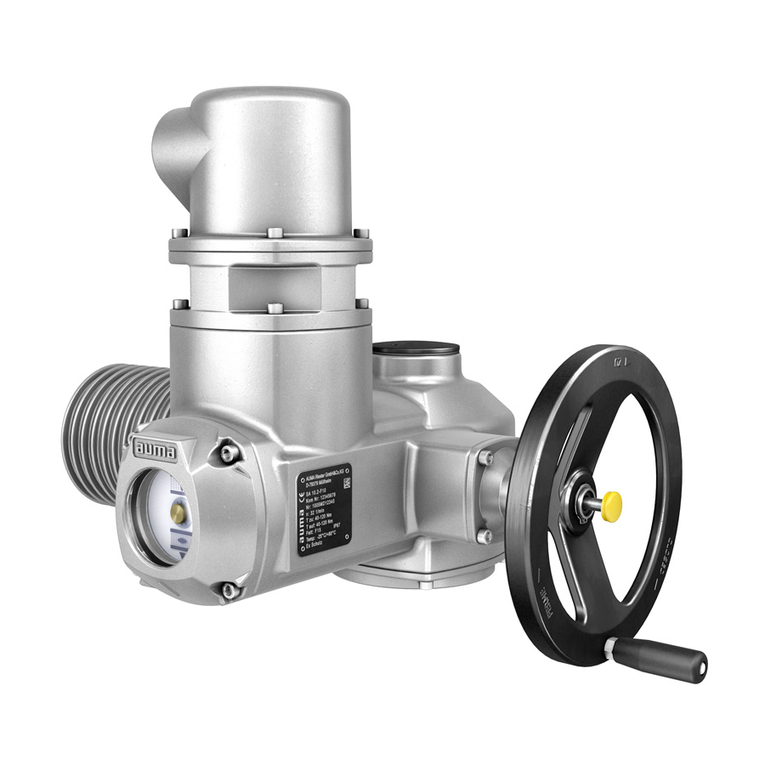
AUMA
AUMA SAEx 07.2 User manual

AUMA
AUMA TIGRON TR-M30X Manual
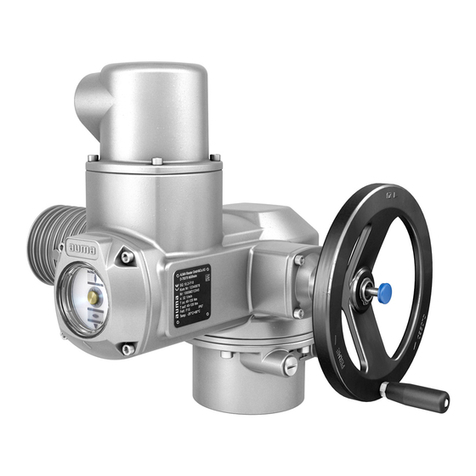
AUMA
AUMA FQM 05.1 User manual
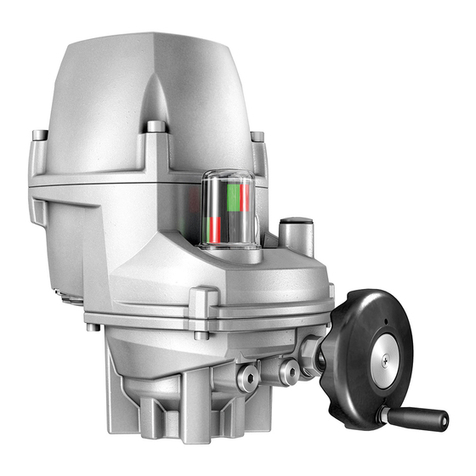
AUMA
AUMA PROFOX PF-Q80 User manual
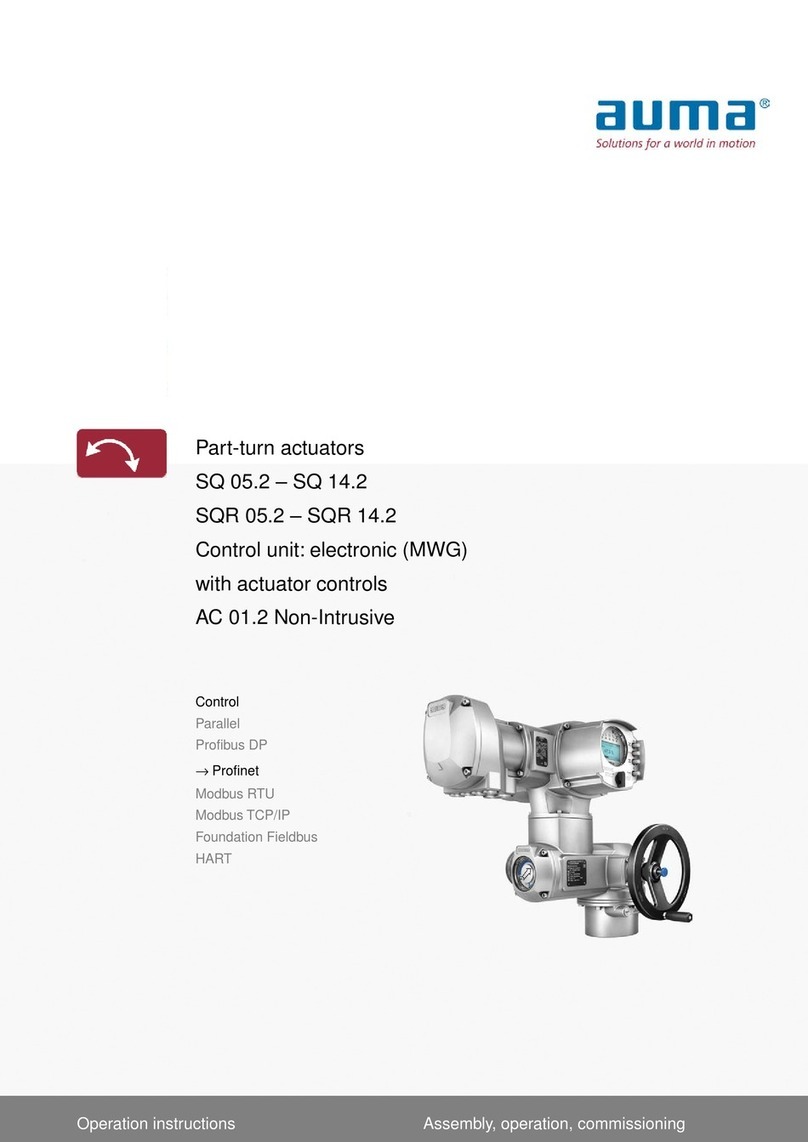
AUMA
AUMA SQ Series User manual
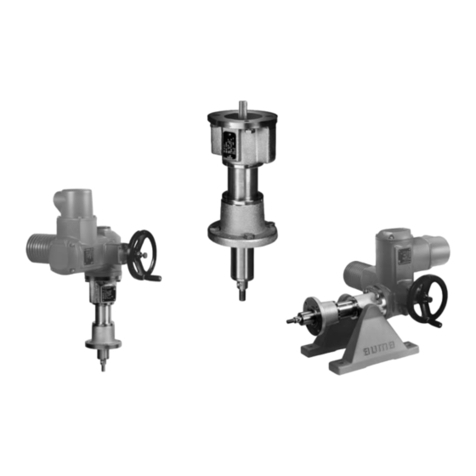
AUMA
AUMA LE 12.1 User manual
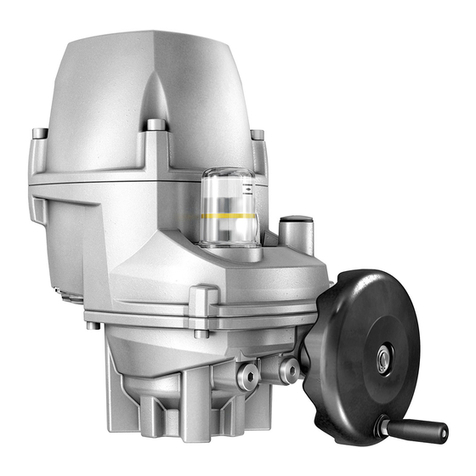
AUMA
AUMA PF-M25 Series Manual
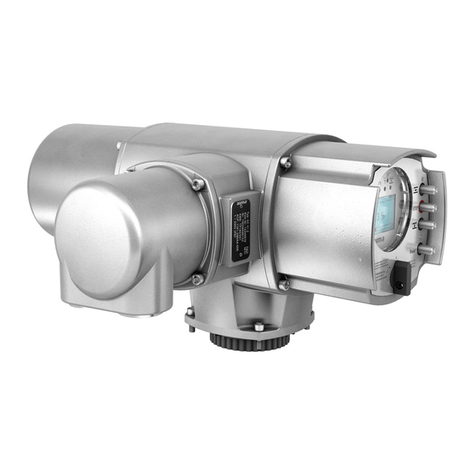
AUMA
AUMA Aumatic AC 01.1 User manual
